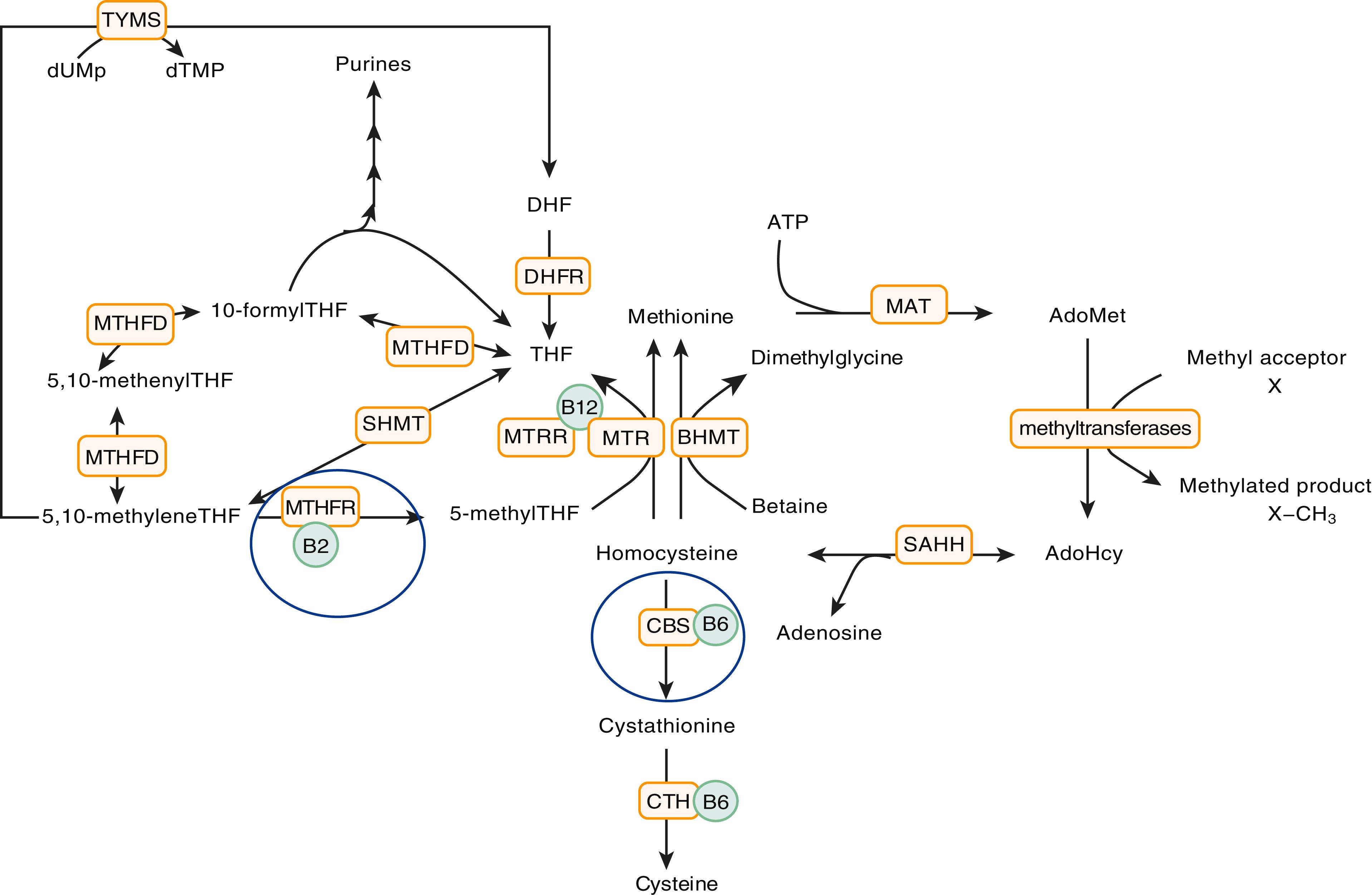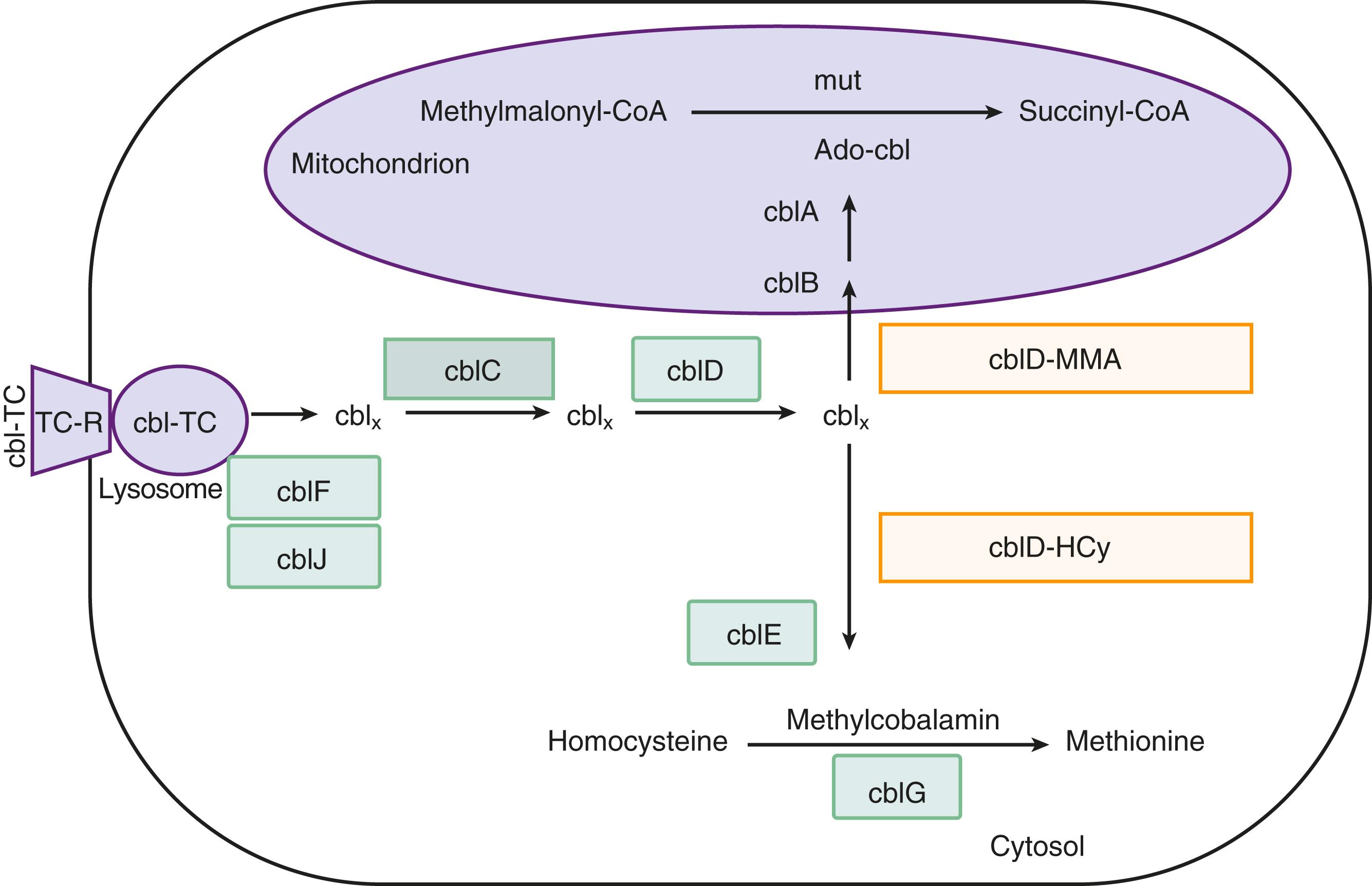Physical Address
304 North Cardinal St.
Dorchester Center, MA 02124
Homocysteine, which is a nonprotein amino acid, is a key metabolic branch point metabolite between the trans-sulfuration and remethylation pathways of methionine metabolism. The many conditions associated with high homocysteine levels encompass a wide range of clinical manifestations. The normal level of plasma total homocysteine is below 15 µM. However, the threshold of total homocysteine above which a disorder of homocysteine metabolism should be suspected and a specific therapy should be initiated is about 50 µM. These metabolic conditions mainly include genetic recessively inherited disorders of homocysteine metabolism but also include acquired severe nutritional deficiencies in cobalamin (cbl, vitamin B 12 ) or folate.
Inherited disorders of homocysteine metabolism ( E-Figs. 193-1 and 193-2 ) comprise disorders of the trans-sulfuration pathway with cystathionine β-synthase deficiency (or classical homocystinuria), and disorders of remethylation of homocysteine to methionine. The latter include 5,10-methylenetetrahydrofolate reductase (MTHFR) deficiency and inherited disorders of cobalamin absorption, transport, or intracellular metabolism, as well as the very rare congenital folate malabsorption disorder. Intracellular remethylation defects share defective methionine synthesis as a common feature, MTHFR deficiency impairs 5-methyltetrahydrofolate (5-methylTHF) synthesis, cobalamin F and cobalamin J defects result in the defective lysosomal release of cobalamin. Cobalamin C and cobalamin D defects result in the abnormal cytosolic reduction and transport of hydroxocobalamin. Cobalamin F, cobalamin J, cobalamin C, and cobalamin D all impair the synthesis of both methyl- and adenosylcobalamin. Isolated deficiencies of methionine synthase (cobalamin E and cobalamin G) are associated with defective methyl cobalamin synthesis as well as the cobalamin D-homocysteine (cblD-Hcy) variant.


In cystathionine β-synthase deficiency, severe elevations of total homocysteine are accompanied by increased levels of plasma methionine. In remethylation disorders, however, the increased total homocysteine is associated with a low (or low-normal) plasma level of methionine owing to the ineffective conversion (remethylation) of homocysteine to methionine. Among the remethylation disorders, the cobalamin C defect (the most frequent inherited disorder of intracellular cobalamin metabolism) and MTHFR deficiency are by far the most frequent.
The worldwide incidence of cystathionine β-synthase deficiency is estimated to be about 0.038/100,000, with a higher incidence in Europe (about 0.72/100,000) and Latin America (about 0.45/100,000) and a lower incidence in Africa (about 0.20/100,000) and Asia (about 0.02/100,000). Studies from the Saudi Arabian countries have shown incidence rates as high as 1 in 1800 live births. The incidence of severe homocysteine remethylation defects has never been evaluated but may be less than 1 in 500,000 live births.
The homocysteine that accumulates in both cystathionine β-synthase deficiency and remethylation defects is a well-known multisystem toxic agent. It exerts its effects either directly or indirectly via conversion to S-adenosylmethionine (AdoHcy) (see E-Fig. 193-1 ), which potentially inhibits many essential methyltransferases. Direct cellular homocysteine toxicity is found with endothelial damage and neuronal cell death. Homocysteine’s effects on vascular endothelium predispose to thrombosis that may occur at any age and involve arteries and/or veins of any size. Specifically in cystathionine β-synthase deficiency, accumulation of homocysteine and/or cysteine deficiency induces modification of connective tissue proteins, possibly causing the skeletal and ocular manifestations of the disease. These effects are probably related to fibrillin, which is rich in cysteine and is a component of the periosteum, perichondrium, and zonular fibers of the ocular lens. The structure of fibrillin can be affected by the linking of homocysteine to cysteine; as a result, some clinical features of homocystinuria overlap with the fibrillin mutations seen in Marfan syndrome ( Chapter 239 ).
Remethylation defects (cobalamin C and MTHFR) not only result in severe elevations of homocysteine but also in depletion of methionine that is required for the synthesis of proteins and of s-adenosylmethionine. The result is a reduction of cellular methylation capacity and accumulation of S-adenosylhomocysteine, especially in the central nervous system (CNS). The cobalamin C defect is an inborn error of intracellular cobalamin metabolism due to a mutation in MMACHC , the gene that encodes methylmalonic aciduria and homocystinuria type C protein. In the absence of normal MMACHC, neither methylcobalamin (the cofactor of methionine synthase) nor adenosylcobalamin (the cofactor of methylmalonyl-CoA mutase) is functional, and the result is secondary defects in methionine synthase (remethylation defect) and methylmalonyl-CoA mutase (methylmalonic acid accumulation), respectively (see E-Fig. 193-2 ). In MTHFR deficiency, the methyl donor 5-methylTHF cannot be produced, which secondarily reduces methionine synthase function and subsequent remethylation. The pathogenesis of MTHFR deficiency can be ascribed to homocysteine toxicity as well as depletion of cellular methionine. In addition, 5-methylTHF (the circulating form of folate) formation is hampered, thereby causing in particular cerebral folate deficiency. One unique mechanism in cobalamin defect is the trapping of 5-methylTHF owing to dysfunction of methionine synthase. Because MTHFR activity is irreversible, 5-methylTHF accumulates. Because this form of folate is not available for metabolism in the cobalamin C defect, it results in cellular folate deficiency. All these disorders are inherited in an autosomal recessive manner ( Table 193-1 ).
| FUNCTIONAL DEFECT | COMMON NAME | ENZYME DEFECT | GENE | CHROMOSOME LOCUS |
|---|---|---|---|---|
| Trans-sulfuration | “Classical” homocystinuria | Cystathionine β-synthase | CBS | 21q22.3 |
| Remethylation | Folate-dependent homocystinuria cblE cblG |
Methylenetetrahydrofolate reductase Methyltransferase reductase Methionine synthase |
MTHFR MTRR MTR |
1p36.3 5p15.2-p15.3 1q43 |
| Cobalamin transport | TC-II cblF |
Transcobalamin Lysosomal B 12 translocase |
TCN2 LMBRD1 |
22q11.2-qter 6q13 |
| Cobalamin processing | cblC cblD cblJ |
Intracellular cobalamin chaperone? Cobalamin reductase? Cobalamin processing? |
MMACHC MMADHC ABCD4 |
1p34.1 2q23.2 14q24.3 |
As an autosomal recessive condition, cystathionine β-synthase deficiency can clinically affect homozygous or compound heterozygous individuals. Affected individuals are normal at birth after an uneventful pregnancy and delivery. If untreated, they progressively develop the core clinical symptoms of cystathionine β-synthase deficiency, which involve four major organ systems. The time of onset of clinical symptoms is extremely variable, and symptoms may first manifest during adulthood or even up to 60 years of age.
Developmental delay and mental retardation affect about 60% of the patients to a variable degree of severity. Seizures, electroencephalogram abnormalities, and psychiatric disturbances occur in approximately half of the cases. Focal neurologic signs may be a consequence of cerebrovascular accidents. IQ in individuals with untreated homocystinuria ranges widely, from 10 to 138. In B 6 (pyridoxine)-responsive untreated individuals, the mean IQ is 79 versus 57 for those who are B 6 -nonresponsive. Neuropsychiatric symptoms can include schizophrenia or autism-like features.
Become a Clinical Tree membership for Full access and enjoy Unlimited articles
If you are a member. Log in here